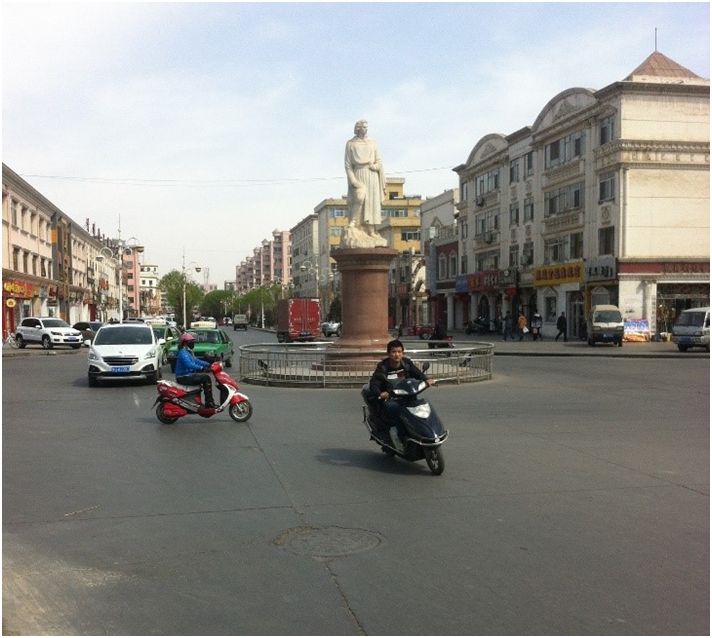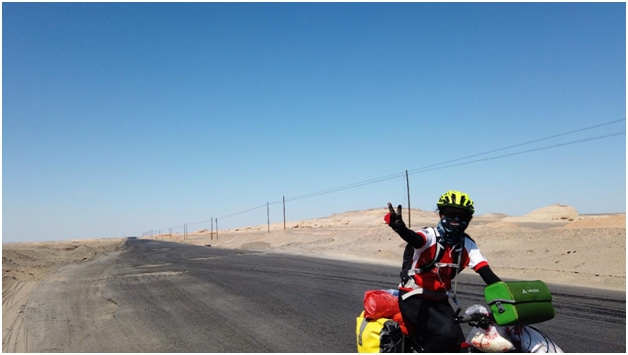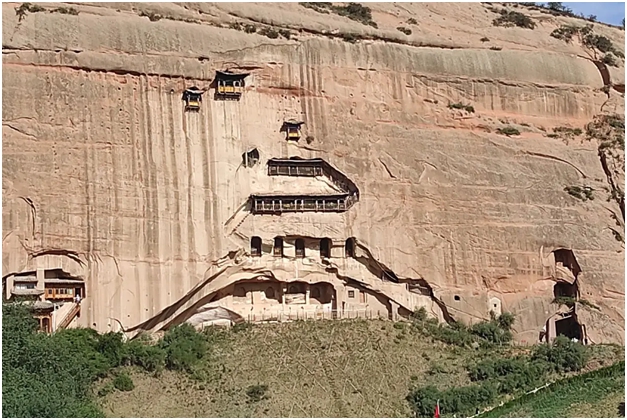Whilst there may be some doubt, many people in China not only believe, but celebrate the fact that Marco Polo lived and travelled in the country. In the city center of Zhangye, in China’s Northwestern province of Gansu, there is a statue of him. It stands proudly in the center of a junction and is used by locals as a roundabout. Marco claimed in his book that he lived there for a year. I’m of the opinion that it’s quite likely he did. But, if he didn’t, then someone he was telling the story about did. Zhangye is a very important crossroad for travelers in a narrow neck of Gansu, going north and south between Qinghai and Mongolia, or east and west along the Ancient Silk Road. Marco could not have known this without some in-depth knowledge.
For most people outside of China, Zhangye is not a well-known name, but its location makes it a very important place. It is extremely dry and, despite being very cold in winter, there is rarely any snow. The summers are incredibly hot and it rarely rains. Historically, there was an oasis, an earlier name of the city is Gan Quan, meaning sweet spring, is a good indication of this and, as someone who has travelled there twice, both times by bicycle across desert roads, there is definitely some truth in the name. Although there’s no evidence of the spring now, it’s a fact that water never tastes better, or as sweet as the first drops, after a desert crossing;and Zhangye is definitely surrounded by desert in this narrow neck of the strangely shaped and slightly elongated province of Gansu.
Modern travelers into Zhangye won’t usually experience this appreciation of the presence of water, but ancient travelers most assuredly would have and nowadays, people like us arriving in the city on our bikes definitely did. On our last visit there, we left Jiuquan to the West, fully loaded with an additional 5 liters of water each. It adds several kilograms of weight to each bike and makes for a tough ride but is necessary, since the riding environment is harsh, and there are dry, hot winds and few stopping places along the way. The distance is about 200 kilometers, and that’s two days of riding and one night camping. So, plenty of water is important.
All the best stories have a basis in truth, and Marco Polo’s travel adventures are no exception. Various rumours of his introduction to Europe of different aspects of Chinese cuisine abound in relation to Marco Polo but it’s quite obvious now that he didn’t introduce pasta to Italy. The history of pasta predates his trip to China, but, as we’ll soon learn, there is a similar food in this region that could be mistaken for, or believed to be the origin of spaghetti. Nor did Marco invent pizza, the pizza story is based on one of the staples of Northwestern China, naan bread, made famous by Xinjiang’s Uyghurs but eaten all throughout the region. It’s a flat based bread cooked on the inside walls of a deep oven and the only toppings would be a sprinkling of salt and some spices. As these Uyghur boys photographed in Xinjiang’s Turpan, about 1200 kilometers to the West of Zhangye will attest, it’s delicious!
There is a statue of Marco Polo in the city center of Zhangye.
The Great Wall, in that part of the world is still evident but it’s not like the iconic Great Wall we see in the East of China. It’s a little more, but not much more, than a fortified embankment designed to stop horses crossing from the North. The Xiongnu, and later the Mongolians, were a constant threat to Northern China and remnants of the wall built to prevent them are found all around Zhangye in the desert today. However, albeit that some parts are nearly a thousand years old they are well-preserved.
What is good news for China, and the world of historians, is that there is much work going on to retain and preserve this wall. A hundred kilometers or so from any major town, we saw some people with tools and buckets seemingly scraping the wall. Ann, my wife was angry. She thought they were trying to steal some ancient parts of China’s history so we stopped to ask them what they were doing and they explained they were a professor and students, working on preserving the wall. They told us that this part was from the Ming Dynasty but some parts were from the Qing dynasty, which means less than 400 years old.
As we walked along and cycled past the remnants of China’s Wall, my wife, Ann, and I were conscious of, and discussed, that this wall would have witnessed history in the making. It was built to prevent further onslaughts from Mongolian hordes who would have crossed or passed by it in raids on China. If only walls could talk, what stories they could tell!I am sure I am not unique in this but there can’t be many of us who have traversed both the Great Walls of the world, Ann and I are privileged to be able to say we have.
Writing about this now brings to mind another aspect of this journey along the Wall. This is the regret of a missed opportunity we sometimes encounter. We met and talked for a few minutes with people working on one of China’s most historic icons, but we didn’t learn much other than they are preserving it. We don’t know where they came from, how long they will be there, what rewards they would achieve and what discomforts they suffered, the road is remote, the work is hard, hot in summer and cold in winter but we left them after just a few moments of chat because we had a destination to reach. There’s no better way to see China than by travelling slowly though the country but, when you have a destination to reach, the destination becomes the target and opportunities missed on the journey are sometimes regretted later.
Zhangye sits at the Eastern end of a windswept pass known as the Hexi Corridor, just a short distance, in modern terms, about two-hundred kilometers, but perhaps 15 or 20 days walk from the Jiayuguan Mouth, a pass between two mountain ranges which span from the Tibetan plateau to Mongolia and marks the start of the this corridor;it’s part of the Gobi Desert and winds in the region can be extreme. These winds can help or hinder the traveler. In 2014 as we left Zhangye, my friend, Phil Behan and I cycled 230 kilometers in a single day with the wind behind us. A few years later, in the same region with the wind in our faces, my wife and another Australian friend cycled only 12 kilometers in 4 hours. The winds were so extreme at one point we stopped riding our bikes hailed a passing car and went into the city to rent a van and driver to go back and pick up the bikes. The wind didn’t ease for several days and, since there is no point attempting to ride against it, we had the good fortune to experience an enforced stay in Zhangye.
One of the greatest aspects of China is the people willing to help and our journey through the Hexi corridor was no exception. The distances between towns here can be enormous. Towns exist only because they used to be the sites of oases for ancient travelers. It would take many days for the traveler to leave Jiuquan and arrive at Zhangye, but now, it’s about a 90-minute drive. Every hour in a car, is a day’s ride on a bike, every hour on a bike is a day’s walk for a hiker but for a merchant with a camel train, it would probably be even longer.
This day was hot, and the wind is best described as like that from a hairdryer. It blows hard and it blows strong. When it blows into your face, it dries the skin, it cracks the lips, it brings dust and dirt into the eyes and it’s the kind of day you question yourself: why am I doing this, what’s my purpose, why didn’t I just stay in the last town until the wind died off. And, to be honest, if we’d turned around and gone back to the last town, it would have been easy, the 12 kilometers we’d covered would have been eaten up in about 10 minutes and we’d be back in the comfort of a small hotel at the side of the entry to a freeway. But we wanted to move forward, not backward, we had no idea how long the winds would last, it could have been days or even weeks.
We were riding close together. I was in front, attempting to help Ann by shielding the worst of the wind and allow her to ride with a little less strain, but it was impossible. We gave up, stopped where we were and discussed our options, shouting at each other because the wind was so strong. Going back was one option, but going forward was a better one. We were 80 kilometers from the city and had to make a decision but travelling only 3-5 kilometers an hour so riding on wasn’t going to work. Ann saw a black car approaching us and hailed it down. The driver stopped, asked what was going on and she explained she’d like to go with them to the next place where there was an ability to rent a truck. They agreed to take her and we(the two men)stayed with the bikes. We expected it would be at least three hours but she was back an hour later with a big smile beaming down from the passenger seat of a flatbed truck.
Jerry Grey on the ride.
The car’s driver had seen here was a large construction site only 20 or so kilometers away and stopped there, waiting until he was sure she had found there was a driver with a truck willing to come and get us. He wouldn’t accept any payment just wished her luck and said goodbye. The foreman of the construction site jumped into the truck with Ann and came to get us. We had left the bikes at the side of the road and walked down the embankment to find a spot out of the wind. We used a few rocks and built ourselves a crude shelter but were barely finished when we saw Ann return.
Anyone crossing into China from the West must traverse the inhospitable Hexi Corridor, so Zhangye provided a stop and resting point for many people from many diverse backgrounds. It remains, to this day, an intermingled city. Gansu, as with the rest of the region has many Muslims, their culture is ubiquitous and Islamic Mosques dot the landscape(The Autonomous Regions of Ningxia(Hui)and Xinjiang(Uyghur)are neighbors). Zhangye is no different, and there are many Muslims in the city too, with so many mosques around the region. It’s clear there are a lot of them and, because of travelers from India, Buddhism is very much part of the local culture with several temples in and around the city such as the Mati Temple which, albeit not as famous as their counterparts in Dunhuang, are every bit as spectacular.
Mati Temple.
Food is another thing that makes this region special. Overseas visitors to the region can wave goodbye to their bacon breakfasts. It’s a predominantly Muslim region, but will experience something incredible in exchange. If someone had told me many years ago that I would enjoy mutton for breakfast, I’d have thought them quite mad but steamed or roast mutton buns have to be tasted to be appreciated, they are delicious. Don’t worry if you don’t know where to find them, just follow your nose. They are cooked everywhere in shops, from stalls and carts in the street, and the aroma will hit you before your eyes see them.
Noodles are a staple of the region but not the kind of noodles we might expect if we come from outside of China. These are hand-crafted, once you order them the chef takes a lump of dough, rolls it, stretches it and, as you watch, it becomes longer and longer, after a few twists and turns, almost like magic before your eyes, the lump of dough is transformed to what Marco Polo would probably have recognized as spaghetti and thrown into a boiling pot of lamb or beef soup. Now we can see where the spaghetti stories came from and the end result is a delicious breakfast, lunch or dinner. Lamb and mutton are served in many different ways but cold nights spent around a barbecue cooking ribs or skewers of meat or slow roast spiced lamb are unforgettable experiences.
Zhangye, like most of Northwestern China is hot in summer, cold in winter and almost always dry, the winds can be strong and uncomfortable but those extremes of nature have crafted a place of profound beauty. It’s also a place of importance and significance in China’s history. It’s also an intermingled region of cultures and religions providing a wide variety of culinary experiences for visitors to try and, although it’s not as well-known as some of its near neighbors like Jiayuguan and Dunhuang, it really is, as Marco Polo can attest, a wonderful place to visit!


